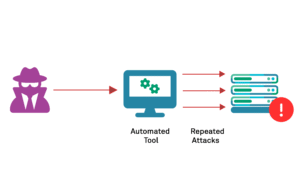In today’s digital landscape, cybersecurity threats are constantly evolving, and one of the most common yet dangerous attacks is the brute force attack. These attacks can compromise sensitive data, lead to unauthorized access, and even bring down entire websites if not properly mitigated.
In this blog post, we’ll explore:
✔ What a brute force attack is
✔ How these attacks work
✔ The different types of brute force attacks
✔ Best practices to protect your website
What Is a Brute Force Attack?
A brute force attack is a hacking method where an attacker systematically tries every possible combination of passwords, encryption keys, or login credentials until the correct one is found. Unlike sophisticated cyberattacks that exploit vulnerabilities, brute force attacks rely on sheer computing power and persistence.
These attacks are often automated using bots that can test thousands of login attempts per second, making them a significant threat to websites with weak security measures.
How Do Brute Force Attacks Work?
-
Target Identification – Attackers identify a vulnerable login page (e.g., WordPress admin, cPanel, or online banking portals).
-
Automated Guessing – Using tools like Hydra, John the Ripper, or custom scripts, they bombard the target with login attempts.
-
Successful Breach – Once the correct credentials are found, attackers gain unauthorized access to the system.
-
Exploitation – The attacker may steal data, install malware, or use the compromised account for further attacks.
Types of Brute Force Attacks
-
Simple Brute Force Attack – The attacker tries all possible password combinations manually or with basic scripts.
-
Dictionary Attack – Uses a pre-defined list of common passwords (e.g., “password123,” “admin,” “123456”).
-
Hybrid Brute Force Attack – Combines dictionary words with random characters (e.g., “admin123”).
-
Reverse Brute Force Attack – The attacker uses a known password and tries different usernames.
-
Credential Stuffing – Uses previously leaked credentials from other breaches to gain access.
How to Protect Your Website from Brute Force Attacks
1. Use Strong, Unique Passwords
-
Enforce complex passwords (minimum 12 characters, with uppercase, lowercase, numbers, and symbols).
-
Avoid common passwords like “admin” or “password123.”
2. Implement Account Lockout Policies
-
Lock accounts after a certain number of failed login attempts (e.g., 5 attempts).
-
Temporarily block suspicious IP addresses.
3. Enable Two-Factor Authentication (2FA)
-
Adds an extra layer of security (e.g., SMS codes, Google Authenticator, or biometric verification).
4. Use CAPTCHA or reCAPTCHA
-
Prevents automated bots from submitting login forms.
5. Limit Login Attempts
-
WordPress plugins like Limit Login Attempts Reloaded can help restrict repeated tries.
6. Monitor and Analyze Login Attempts
-
Use security tools like Fail2Ban to detect and block brute force attempts in real-time.
7. Keep Software Updated
-
Regularly update CMS platforms (WordPress, Joomla), plugins, and server software to patch vulnerabilities.
8. Use Web Application Firewalls (WAF)
-
Services like Cloudflare, Sucuri, or ModSecurity can block malicious traffic before it reaches your site.
9. Disable Unnecessary Login Pages
-
Restrict access to admin panels (e.g., change default
/wp-adminto a custom URL).
10. Regularly Backup Your Website
-
In case of a breach, backups ensure quick recovery without data loss.
Final Thoughts
Brute force attacks remain a persistent threat, but with the right security measures, you can significantly reduce the risk of a breach. By enforcing strong passwords, enabling 2FA, and using security plugins, you can safeguard your website from unauthorized access.
Stay proactive, monitor your site for suspicious activity, and always keep your security protocols up to date. A secure website not only protects your data but also builds trust with your users.
🔒 Need help securing your website? Contact us for website Penetration Testing to secure your website today!



